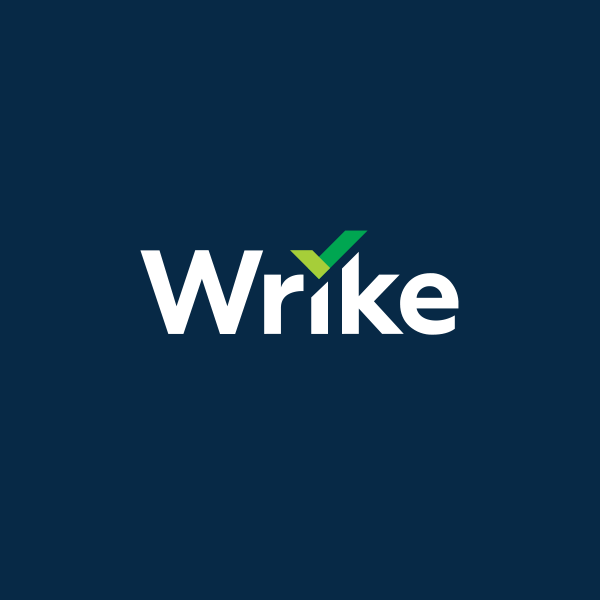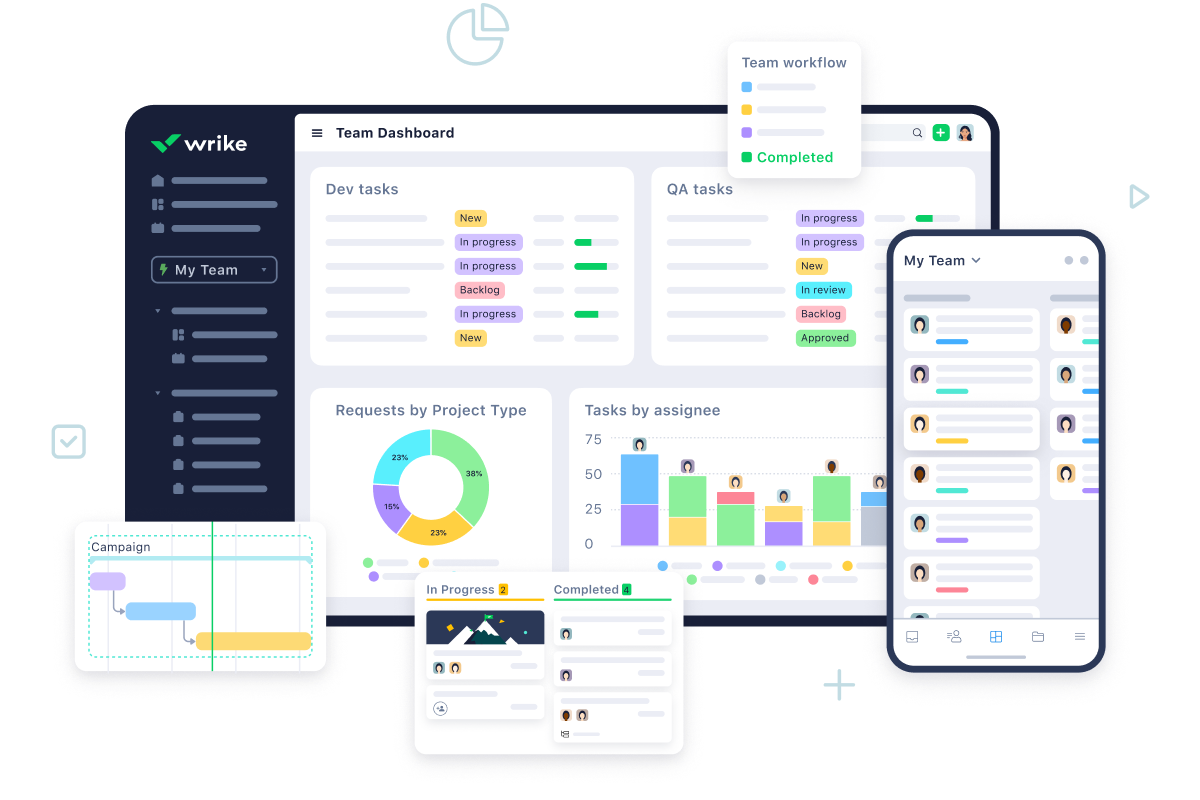Back to all comparisons
Asana vs Wrike
Comprehensive comparison to help you choose the right tool for your needs

Asana
4.5
Asana is a project management tool focused on team collaboration and work organization, offering multiple views for task management, app integrations, and AI features for efficiency. It's suitable for various team sizes, streamlining workflows and aligning goals.
Asana offers three plans: the free Personal plan for basic needs, the Starter plan at $11.59 for expanded features like timeline view, and the Advanced plan at $25.69 for comprehensive project management tools including time tracking and advanced customization.
Visit Website 
Wrike
4.6
Wrike is a comprehensive project management tool offering workflow automation, data visualization, and collaboration features for teams.
Free, Professional at $9.80/user, Business at $24.80/user, and Enterprise. Each varies by features and team size
Visit Website Quick Summary
Asana Strengths
- Task Management: Asana excels in task management, allowing users to create, assign, and track tasks efficiently. This feature ensures that team members are always aware of their responsibilities and deadlines, promoting productivity and accountability.
- Project Visualization: With options like Kanban boards and Gantt charts, Asana offers versatile visualization tools. These features aid in understanding the project flow and milestones, making it easier to manage timelines and resources.
- Team Collaboration: Asana fosters seamless team collaboration. It allows for easy communication within tasks, sharing of files, and updating progress, thus keeping everyone on the same page and enhancing teamwork.
- Integration Capabilities: The platform integrates with a wide range of other applications and tools, streamlining workflows and automating processes. This integration makes it a flexible tool that can adapt to various business ecosystems.
Wrike Strengths
- Interactive Gantt Charts: Wrike's Gantt charts allow users to visualize project timelines and dependencies. This feature helps in planning and adjusting schedules with simple drag-and-drop adjustments, facilitating easy management of complex project timelines.
- Real Time Collaboration: Teams can collaborate in real time, with updates and communications happening instantly across the platform. This ensures that all team members are on the same page and can react quickly to changes or updates.
- Customizable Dashboards: Wrike offers fully customizable dashboards that give users control over what data they see and how it's presented. This helps in tracking the most relevant project metrics and individual tasks, tailoring the view to meet specific needs or roles within a team.
- Integrated Resource Management: The software includes tools for resource allocation and management, allowing managers to oversee team workloads, plan capacity, and distribute tasks efficiently to avoid overloading employees.
Asana Screenshot

Wrike Screenshot

Feature Comparison
| Feature | Asana | Wrike |
|---|---|---|
| Platforms | macOS, iOS, Android, Web, and Windows | Yes |
| Integrations | Google Drive, Slack, Zoho Cliq, Zapier, Jira, Zoom, Toggl Track, Loom, Harvest, Gmail | Salesforce, Microsoft Teams, Google Drive, Slack, Adobe Creative Cloud, and Zoom |
| Calendar | Yes | Yes |
| Task Management | Task creation and assignment, due date setting, progress tracking, project organization, tagging, comments, file attachments, task conversations | Task Creation and Updating, Multiple Viewing Options, Time Tracking, Templates, Comprehensive Task Reports, Task history logging, File Uploads and Sharing capabilities |
| Natural Language Processing | Yes | No |
| Analytics | Yes | Yes |
| Time Blocking | No | Yes |
| Time Zones | Yes | Yes |
| Scheduler | No | Yes |
| Notifications | Yes | Yes |
| Pricing | Asana offers three plans: the free Personal plan for basic needs, the Starter plan at $11.59 for expanded features like timeline view, and the Advanced plan at $25.69 for comprehensive project management tools including time tracking and advanced customization. | Free, Professional at $9.80/user, Business at $24.80/user, and Enterprise. Each varies by features and team size |
| Customer Support | Average | Good |
Video Overview
Asana Video
Wrike Video
Asana Overview
Asana stands out as a versatile project management tool, ideal for various team sizes. Its user-friendly interface, coupled with diverse features like task management, project visualization (including Kanban and Gantt charts), and robust team collaboration tools, makes it a top choice. Additionally, Asana's integration capabilities with other apps enhance workflow efficiency. Offering a range of pricing plans, including a free version for smaller teams, Asana caters to a broad spectrum of organizational needs. It's particularly recommended for its ease of use, extensive integrations, and comprehensive project management features.
Pricing Details
Asana offers three main pricing tiers: (i) Personal: This is a free plan, suitable for small teams or individuals. It includes basic project and task management features and supports collaboration with up to 10 team members. Users have access to unlimited tasks, projects, messages, and file storage. (ii) Starter: Priced at $11.59 per user per month, this plan builds on the Personal plan. It allows collaboration with up to 500 teammates and introduces additional features like timeline and Gantt chart views, along with the ability to use forms and automation. (iii) Advanced: At $25.69 per user per month, the Advanced plan includes all features from the lower tiers and adds functionalities such as goals, time tracking, proofing, approvals, and more advanced customization options. Each tier offers a range of features to accommodate different needs, from individual use to more complex team collaboration and project management requirements.
Wrike Overview
Wrike is a project management software designed to help teams manage their workspace and projects more efficiently. It offers a traditional interface with a wide range of functionalities including tables, boards, Gantt charts, and templates for collaboration across remote, hybrid, and in-person teams. Wrike supports various types of file proofing and integrates well with other tools like Miro, Microsoft Teams, and Slack. It is particularly popular among marketing and sales teams for its resource management and time logging features.
Pricing Details
Wrike offers several pricing plans based on the size and needs of teams. Here's a brief overview: (i) Free Plan: Designed for teams just starting out, offering basic project management features with limitations on active tasks. (ii) Professional Plan: Costs $9.80 per user/month, suitable for teams of 2-25 users, offering unlimited projects, tasks, and 2 GB of storage per user. (iii) Business Plan: Priced at $24.80 per user/month, tailored for larger teams, it includes comprehensive project management tools, automation, approvals, and 5 GB of storage per user. (iv) Enterprise Plan: For large teams needing enterprise-grade security and scalability, with pricing available upon contact. It includes advanced security features, automation, and 10 GB of storage per user. (v) Pinnacle Plan: Aimed at teams with complex work needs, offering advanced analytics, 15 GB of storage per user, and premium features, with pricing available upon request.
Asana Key Features
Task Management: Asana excels in task management, allowing users to create, assign, and track tasks efficiently. This feature ensures that team members are always aware of their responsibilities and deadlines, promoting productivity and accountability.
Project Visualization: With options like Kanban boards and Gantt charts, Asana offers versatile visualization tools. These features aid in understanding the project flow and milestones, making it easier to manage timelines and resources.
Team Collaboration: Asana fosters seamless team collaboration. It allows for easy communication within tasks, sharing of files, and updating progress, thus keeping everyone on the same page and enhancing teamwork.
Integration Capabilities: The platform integrates with a wide range of other applications and tools, streamlining workflows and automating processes. This integration makes it a flexible tool that can adapt to various business ecosystems.
Customization and Reporting: Asana offers extensive customization options, including custom fields and reporting features. These allow teams to tailor their project management experience and generate insightful reports for better decision-making.
User-Friendly Interface: The intuitive interface of Asana is designed for ease of use, making it accessible for teams regardless of their technical expertise. This simplicity ensures a smooth onboarding process and enhances overall user experience.
Wrike Key Features
Interactive Gantt Charts: Wrike's Gantt charts allow users to visualize project timelines and dependencies. This feature helps in planning and adjusting schedules with simple drag-and-drop adjustments, facilitating easy management of complex project timelines.
Real Time Collaboration: Teams can collaborate in real time, with updates and communications happening instantly across the platform. This ensures that all team members are on the same page and can react quickly to changes or updates.
Customizable Dashboards: Wrike offers fully customizable dashboards that give users control over what data they see and how it's presented. This helps in tracking the most relevant project metrics and individual tasks, tailoring the view to meet specific needs or roles within a team.
Integrated Resource Management: The software includes tools for resource allocation and management, allowing managers to oversee team workloads, plan capacity, and distribute tasks efficiently to avoid overloading employees.
Advanced Security Features: Wrike provides robust security measures, including role-based access control, to ensure that sensitive project data is protected and only accessible to authorized personnel.
Automation Tools: With Wrike, repetitive tasks can be automated using custom workflows, which saves time and reduces the potential for human error. This feature supports a smoother project flow and improves overall efficiency.
Conclusion: Which Tool Should You Choose?
Both Asana and Wrike offer unique features and benefits for productivity and workflow management. The best choice depends on your specific needs, team size, and workflow preferences.
Choose Asana if:
- Task Management: Asana excels in task management, allowing users to create, assign, and track tasks efficiently. This feature ensures that team members are always aware of their responsibilities and deadlines, promoting productivity and accountability.
- Project Visualization: With options like Kanban boards and Gantt charts, Asana offers versatile visualization tools. These features aid in understanding the project flow and milestones, making it easier to manage timelines and resources.
- Team Collaboration: Asana fosters seamless team collaboration. It allows for easy communication within tasks, sharing of files, and updating progress, thus keeping everyone on the same page and enhancing teamwork.
Choose Wrike if:
- Interactive Gantt Charts: Wrike's Gantt charts allow users to visualize project timelines and dependencies. This feature helps in planning and adjusting schedules with simple drag-and-drop adjustments, facilitating easy management of complex project timelines.
- Real Time Collaboration: Teams can collaborate in real time, with updates and communications happening instantly across the platform. This ensures that all team members are on the same page and can react quickly to changes or updates.
- Customizable Dashboards: Wrike offers fully customizable dashboards that give users control over what data they see and how it's presented. This helps in tracking the most relevant project metrics and individual tasks, tailoring the view to meet specific needs or roles within a team.